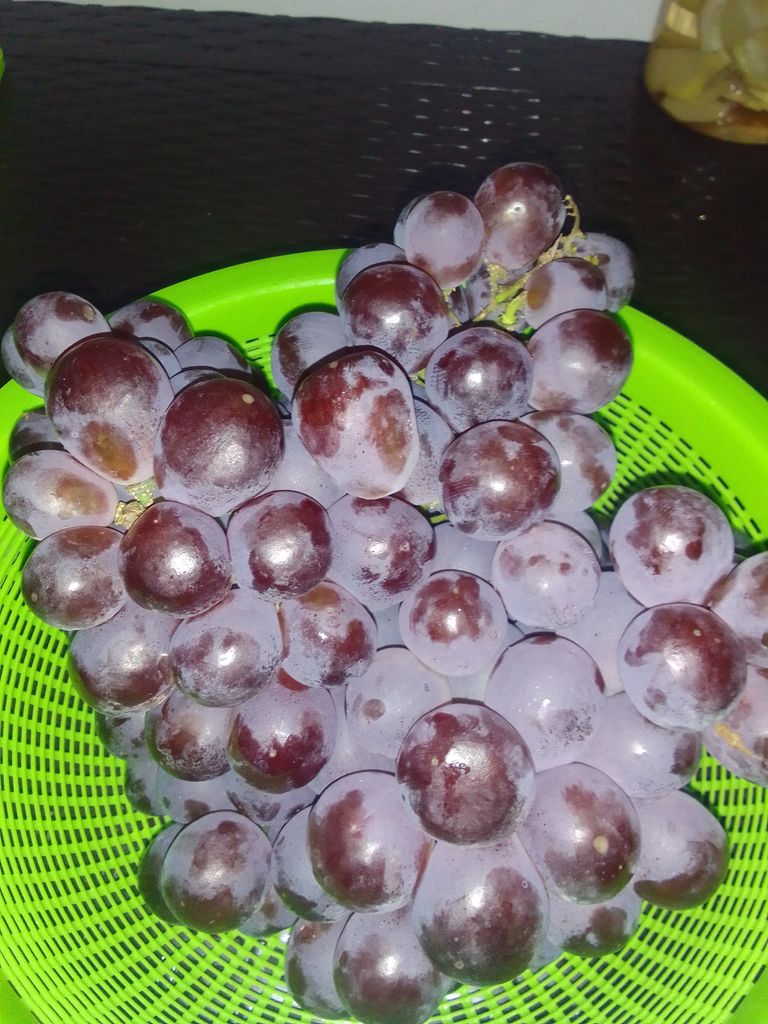We bought this seeded grapes yesterday,its 100 pesos per kilo we bought 2 kilos since i have planning to make fruit salad!

*Seedless Grapes vs Seeded Grapes:
•With over 80 percent of the market, seedless grapes have become the norm in the U.S. food market. They’ve become such a mainstay that many consumers are shocked when they find a seed in a grape. Still, both types of grapes have their advantages.
*How Do Seedless Grapes Exist?
Without seeds, plants can’t reproduce. However, science and horticulturalists have cross-breed grapes for over a century to produce a grape that’s seedless sustainable, yet has no pit. To sustain a seedless grape tree, growers slice branches from the tree and place them in water, effectively growing another tree without harming the grape supply.
Seeded grapes reproduce and grow just like any other type of plant. During processing, growers keep a certain number of grapes and use the seeds to produce another crop of trees. Unlike seedless grapes, seeded grapes don’t require any additional growing techniques to maintain. Wine grapes are the most cultivated seeded grapes in the United States and around the globe, as many vintners, or winemakers, prefer their flavor in the winemaking process.
*Benefits of Seedless Grapes:
If you’ve been to the supermarket recently, chances are you’ve only noticed seedless grapes. Because they’re easier and more enjoyable to eat, many consumers prefer them over seeded options.
Seedless grapes are also highly nutritious, containing phytonutrients, antioxidants, and vitamins. In a side-by-side comparison, red grapes have more nutrients than white grapes, offering higher amounts of Vitamin C, Vitamin K, flavonoids, and phytonutrients.
*Benefits of Seeded Grapes:
Seeded grapes are far less common than their seedless siblings, but they’re still packed with every bit as much nutrition. While many consumers are annoyed by locating, spitting out, and throwing away the seed, these grapes provide an added benefit with one caveat: you have to eat the seed.
Grape seeds are one of the most nutritious parts of the grape, containing melatonin and many of the most powerful antioxidants found on the planet. These antioxidants provide a plethora of benefits such as lowering blood pressure, reducing cholesterol, and preventing heart disease.
Eating grape seeds is all about your individual preference and taste. Some people extract them before eating, but to get all the nutrition, simply move them aside with your tongue and swallow them whole. If you bite into them, you’ll get a bitter sensation, which many believe has a complimentary taste to balance the sweetness of the grapes. If you’re feeling particularly adventurous, you can also save the grape seeds and turn them into grapeseed oil, which is ideal for all types of cooking

Benefits of eating Grapes
Grapes can help with weight loss or management.
Grapes are a low-calorie, fat-free food with a low glycemic index. These vine-growing goodies also contain compounds with antioxidant properties. One of them, resveratrol, is thought to trigger certain reactions that may improve energy metabolism. A 2016 study also linked diets high in antioxidants with weight maintenance. Plus, one cup of grapes has about 100 calories, making them a high-volume, nutrient-dense snack that you can eat more for a lower calorie cost.They're a good source of vitamin K and vitamin C.
The vitamin K in grapes and other produce supports healthy bones and tissues, while the antioxidant vitamin C promotes healing and helps your body absorb iron. Here's what else you'll get in a one-cup serving of red or green grapes:Grapes are an anti-inflammatory food.
Like other plant-based foods, the antioxidants in grapes may reduce cellular damage by protecting cell membranes. Eating about 1 to 2 cups of grapes per day can help shield your tissues by limiting the chemical reactions that trigger inflammation in your body.They're a heart-healthy snack.
When it comes to cardiovascular health, grapes are overachievers. Some compounds in grapes can help regulate blood pressure, reduce inflammation from oxidative stress, improve blood flow, and protect your vascular system.Eating grapes can help your skin.
Specific phytonutrients found in colorful fruits and veggies like grapes may shield skin cells from the effects of ultraviolet light radiation, according to some small studies. Also try eating more watermelon, kiwi, berries, nuts, olives, and fish for a more radiant glow.Your brain may benefit from grapes.
Grape polyphenols may boost cognition and protect your noggin by maintaining vascular health and function. They may also play a role in signaling neurotransmitters and reducing your risk of harmful oxidation, both linked to a lower risk of cognitive decline as a part of a plant-based diet.They can lower your risk of diabetes.
Resveratrol, one of immune-boosting antioxidants found in grapes, is specifically linked to improving blood sugar regulation by affecting carbohydrate metabolism. That said, grape-flavored products can contain lots of added sugar, which has the reverse effect! Make sure you're eating grapes in their least-processed form (fresh or freeze-dried grapes or wine!) to reap the benefits.They count toward hydration.
Little known fact: Grapes are 82% water. Proper hydration is directly linked to skin appearance, cell regeneration, and overall health. You get H2O from more than just beverages, though. High-water foods like — you guessed it — grapes can help your skin stay hydrated too.Eating more grapes can reduce risk of some cancers.
The benefits of veggies and fruit make them no-brainers when it comes to choosing meals and snacks. High-antioxidant foods like grapes are linked to a lower risk of some cancers by protecting cellular DNA, reducing oxidative stress, and limiting reactions that initiate tumor growth and development.Drinking grapes has benefits, too!
As if you needed another reason to pop a bottle: The phenolic compounds in grapes are still present after they've undergone the fermentation process, a.k.a. when they become vino. A whole host of research links regular wine consumption (in moderation, of course!) to a reduced risk of chronic disease and improved health overall. We'll drink to that!
*Have A Wonderful Sunday To All Of Us!🤗😍
THANK YOU FOR ALWAYS SUPPORTING MY BLOGS!💖🥰
Congratulations, your post has been curated by @dsc-r2cornell. You can use the tag #R2cornell. Also, find us on Discord
Felicitaciones, su publicación ha sido votada por @ dsc-r2cornell. Puedes usar el tag #R2cornell. También, nos puedes encontrar en Discord